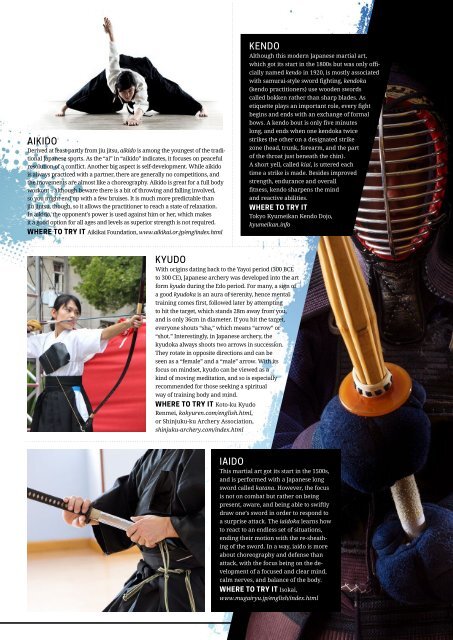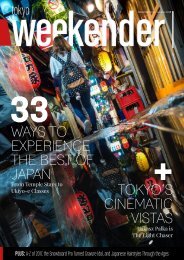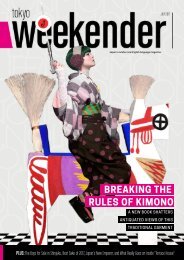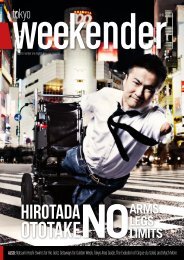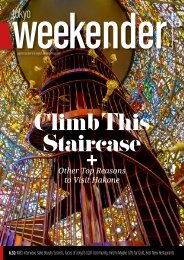Tokyo Weekender January 2017
Jimmy Carr live in Tokyo Plus: 7 Places in Japan You Must Visit in 2017, Change the Way You Work Out, and Kotatsu Dining
Jimmy Carr live in Tokyo
Plus: 7 Places in Japan You Must Visit in 2017, Change the Way You Work Out, and Kotatsu Dining
Create successful ePaper yourself
Turn your PDF publications into a flip-book with our unique Google optimized e-Paper software.
AIKIDO<br />
Derived at least partly from jiu jitsu, aikido is among the youngest of the traditional<br />
Japanese sports. As the “ai” in “aikido” indicates, it focuses on peaceful<br />
resolution of a conflict. Another big aspect is self-development. While aikido<br />
is always practiced with a partner, there are generally no competitions, and<br />
the movements are almost like a choreography. Aikido is great for a full body<br />
workout – although beware there is a bit of throwing and falling involved,<br />
so you might end up with a few bruises. It is much more predictable than<br />
jiu jiutsu, though, so it allows the practitioner to reach a state of relaxation.<br />
In aikido, the opponent’s power is used against him or her, which makes<br />
it a good option for all ages and levels as superior strength is not required.<br />
WHERE TO TRY IT Aikikai Foundation, www.aikikai.or.jp/eng/index.html<br />
KENDO<br />
Although this modern Japanese martial art,<br />
which got its start in the 1800s but was only officially<br />
named kendo in 1920, is mostly associated<br />
with samurai-style sword fighting, kendoka<br />
(kendo practitioners) use wooden swords<br />
called bokken rather than sharp blades. As<br />
etiquette plays an important role, every fight<br />
begins and ends with an exchange of formal<br />
bows. A kendo bout is only five minutes<br />
long, and ends when one kendoka twice<br />
strikes the other on a designated strike<br />
zone (head, trunk, forearm, and the part<br />
of the throat just beneath the chin).<br />
A short yell, called kiai, is uttered each<br />
time a strike is made. Besides improved<br />
strength, endurance and overall<br />
fitness, kendo sharpens the mind<br />
and reactive abilities.<br />
WHERE TO TRY IT<br />
<strong>Tokyo</strong> Kyumeikan Kendo Dojo,<br />
kyumeikan.info<br />
KYUDO<br />
With origins dating back to the Yayoi period (300 BCE<br />
to 300 CE), Japanese archery was developed into the art<br />
form kyudo during the Edo period. For many, a sign of<br />
a good kyudoka is an aura of serenity, hence mental<br />
training comes first, followed later by attempting<br />
to hit the target, which stands 28m away from you,<br />
and is only 36cm in diameter. If you hit the target,<br />
everyone shouts “sha,” which means “arrow” or<br />
“shot.” Interestingly, in Japanese archery, the<br />
kyudoka always shoots two arrows in succession.<br />
They rotate in opposite directions and can be<br />
seen as a “female” and a “male” arrow. With its<br />
focus on mindset, kyudo can be viewed as a<br />
kind of moving meditation, and so is especially<br />
recommended for those seeking a spiritual<br />
way of training body and mind.<br />
WHERE TO TRY IT Koto-ku Kyudo<br />
Renmei, kokyuren.com/english.html,<br />
or Shinjuku-ku Archery Association,<br />
shinjuku-archery.com/index.html<br />
IAIDO<br />
This martial art got its start in the 1500s,<br />
and is performed with a Japanese long<br />
sword called katana. However, the focus<br />
is not on combat but rather on being<br />
present, aware, and being able to swiftly<br />
draw one’s sword in order to respond to<br />
a surprise attack. The iaidoka learns how<br />
to react to an endless set of situations,<br />
ending their motion with the re-sheathing<br />
of the sword. In a way, iaido is more<br />
about choreography and defense than<br />
attack, with the focus being on the development<br />
of a focused and clear mind,<br />
calm nerves, and balance of the body.<br />
WHERE TO TRY IT Isokai,<br />
www.mugairyu.jp/english/index.html<br />
TOKYO WEEKENDER | JANUARY <strong>2017</strong> | 27


